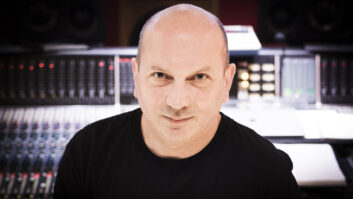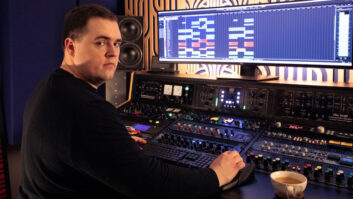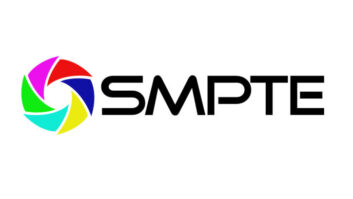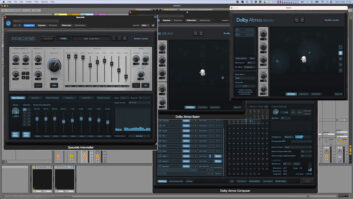Among the most inspired and significant bodies of work that the reissue geniuses at Rhino Records have undertaken is the Rhino Movie Music/Turner Classic Movies series. This arrangement between two companies at the forefront of their fields has led to the release not only of remastered soundtracks for classics such as The Wizard of Oz and Gone With the Wind, but also of the first-ever-available scores of Casablanca and Meet Me in St. Louis, among others. There have also been a number of outstanding collections created especially for the Rhino/Turner imprint, including The Gershwins in Hollywood double-CD and a more recent gem, Irving Berlin in Hollywood.
The Berlin CD contains an impressive selection of some of the most popular recordings ever made for American musicals, representing films such as Top Hat, Alexander’s Ragtime Band, The Jazz Singer, Easter Parade and more. There are also outtakes from some of the films, including rare beauties such as the version of Judy Garland and Howard Keel singing “They Say It’s Wonderful” from Annie Get Your Gun, recorded before Garland had to drop out of the film.
Like most of the Rhino/Turner releases, this CD was produced by Turner Entertainment’s George Feltenstein. He originally conceived of the series when he was working for MGM/UA home video in the ’80s and, almost accidentally, discovered an audio treasure trove. “In ’89, we were producing a special restored video cassette of the film Meet Me in St. Louis,” he explains, “and there was a song in that film that was cut before the film was released called ‘Boys and Girls Like You and Me’ sung by Judy Garland and written by Rogers & Hammerstein, and we knew that the film footage no longer existed. So, I asked, ‘Well, are there recordings?’ And a gentleman who had been in the MGM sound department and now worked for Turner for years said, ‘Oh, yeah, we’ve got about a thousand reels right here.’ And I walked into the vault, and sitting there were literally over 1,000 reels of recordings from all of the MGM films from the ’30s, ’40s and early ’50s.”
It didn’t take Feltenstein long to realize what a magnificent opportunity had been revealed when those vault doors opened. “These audio tapes had not been touched,” he says, “and on these tapes were not only things that we’ve heard before in the final films, but outtakes. And, more importantly, MGM pioneered recording their music with multiple microphones as early as 1931. Each microphone would be attached to a different optical film recorder, and they would take these optical pieces of film and mix them to create one monaural track; there was, of course, nothing like stereo reproduction at that time. Well, those separate pieces were saved onto 11/44-inch magnetic tape, and these are the thousands of reels that I was looking at.” In other words, he would have the benefit of working with multiple tracks, recorded long before multitrack recording existed.
Some time later, Feltenstein moved over to Turner from MGM, following the deal that had been his brainchild. He now serves as a Turner senior VP of marketing, as well as producer of most of the CDs in the Rhino/Turner series. “[On any of these projects] first I put together a track listing,” he explains, “a wish list of everything I’d want to be on [a given release], and then I also take into consideration what’s been out before, what hasn’t. [I try to] come up with a couple of rarities that the collectors would want that have never been out there before and yet make sure that if this is for someone who is a first-time buyer of this material, they’re getting a cohesive, comprehensive overview.”
Then the viability of Feltenstein’s wish list is evaluated by Rhino’s sales department and, once approved, is forwarded to the licensing department, “because, of course, not all the great Irving Berlin music is in movies within our library, even though we do have this huge, wonderful library,” Feltenstein says. “For example, if you’re going to do Irving Berlin in Hollywood, you have to think of having ‘White Christmas,’ but we couldn’t get it. We were able to include some tracks from 20th Century Fox, though, and that was a personal thrill for me.”
After a track list is finalized, Feltenstein goes to work researching the best sources. The source material, if on optical or magnetic film stock, is transferred to DAT or DA-88 at Chace Productions (profiled in last month’s Post Script section).
The digital transfers or 11/44-inch tape masters are then taken to Audio Mechanics to be mastered by engineer Doug Schwartz, who, you could say, has this type of music in his blood: His father was lead clarinetist in the Glen Miller Orchestra, and his mother was one of the Clark Sisters, who sang with Tommy Dorsey’s orchestra; both had long, successful careers as Hollywood session musicians. So, he has a unique ability to appreciate these recordings. “Not only are you working with great composers,” he says, “but you’re listening to 60 to 90 of the greatest musicians of their, or any, time. This, for me, represents a certain apex of musicianship that today we only have a shadow of. There were so many great players and singers on staff at various studios, all able to sight-read flawlessly whatever was thrown down in front of them, and to be on staff at MGM meant you were the creme de la creme. For me, it’s a personal thrill to hear my parents performing, and many family friends as well.”
Schwartz co-owns the two-room Audio Mechanics with his partner, John Polito. Schwartz’s room is equipped with what he calls a “full-blown” Sonic Solutions system, with the complete suite of audio restoration hardware and software. He also uses a Studer A80 (with electronics modified by Patrick Weber Engineering) for playing back the 11/44-inch master tapes, and Wadia A/D converters. He listens on Dunlavy SC6 monitors. There are also Avalon analog EQs and compressors, and JVC digital EQ and compression. He’s quick to point out, however, that he uses his chosen tools judiciously. “These historic recordings should be represented as they were originally conceived and produced,” he says. “It’s not my place to take them and alter them greatly or add effects. The MGM stage is widely regarded as one of the best recording stages ever built; its sound is very much a characteristic of MGM pictures. Digital reverbs can’t hold a candle to that ambience.
“The only thing that we do that is an alteration and that is an accommodation to today’s taste is that, in the cases where we have the multiple angles of orchestras that originally were heard in mono, we will present it in stereo. They’re discrete channels of orchestra that we are lucky to have, and to be able to line them up and give a greater sense of the space of the room is a great gift.”
Schwartz and Feltenstein also get creative with their sources for some of these recordings, to create more fully realized stereo versions of the songs. One of the tracks that Feltenstein found particularly challenging (and satisfying) on the Berlin collection was “Steppin’ Out With My Baby” from Easter Parade, which was recorded in 1947. “The funny thing is that with a lot of the films that MGM did in the late ’40s, a lot of recordings are incomplete or have disappeared completely,” Feltenstein says. “There’s a whole period from about 1947 to ’50 where maybe they used a bad film stock, and these things had deteriorated by the early ’60s. Easter Parade is one of the films for which very little of the actual prerecorded material survived. It was also one of the first Rhino/Turner albums, and it was done during that period where I hadn’t left MGM yet. I didn’t produce the album, and a lot of it, in my opinion, wasn’t quite up to snuff in terms of what it could be sonically.
“With ‘Steppin’ Out With My Baby,’ I found that we had the orchestra track to the beginning of the song and the choral track to the beginning of the song, but no Fred Astaire. What they used on the original album was basically a cleaned-up playback disc, so the song was there, but it was very midrange with a lot of hiss. I thought that if we could find the original mono soundtrack album master, we could use that in the center channel as Fred’s vocal and then wrap the chorus around it to come up with stereo and make it sound great. But that required an enormous amount of painstaking work and editing with Doug. We did it, though, and when people hear this and compare it to how it sounded on the previous album, it’s shocking.”
Speaking of Astaire, working with tap dancing sounds is also a natural part of this process. The taps were not just part of a lavish movie spectacle; they were also important percussive elements in the orchestration of many of these songs. Schwartz says that, in most cases, MGM also recorded the taps to a separate microphone, so Feltenstein can decide when the taps serve as important parts of the arrangement, vs. when they might start to get in the way of an audio only version.
Another song that required a bit of treasure-hunting was “Colonel Buffalo Bill” from Annie Get Your Gun. “That movie was originally supposed to be made with Judy Garland and Frank Morgan,” Feltenstein reminds us, “but Judy Garland, as we know, got ill and could not complete the film and it was recast with Betty Hutton. Also during that period of time [while they were recasting], Frank Morgan died, so he was replaced. Anyway, I found the original recording for his version of Colonel Buffalo Bill, and it’s five channels of music, so it’s mega stereo and it’s amazing. It’s not the most famous Irving Berlin song of all time, but the reason it’s there [on the compilation] is it’s so rare, and it sounds great.”
“That track was pretty involved,” Schwartz says. “That’s an instance where we had a channel of Howard Keel, who is the main vocalist in the second half of the thing, and then we had a couple of channels of other actors, so we had separate pieces of all these different elements, and for each of those I went through and cleaned them up, meaning I took out any noises, optical clicks and pops, that sort of thing, as well as a light DeNOISE on each of the channels. Then there was the considerable job in editorial of putting that together and synching things back up so that Keenan Wynn came in where he is supposed to and so did Howard Keel.”
At press time, Schwartz and Feltenstein had begun working on the next major release in the Rhino/Turner series, The Lion’s Roar, a double-CD collection of excerpts from extraordinary MGM scores. “Would that we could do full, complete scores for more of these pictures, the way we did for Gone With the Wind and Casablanca,” Schwartz says. “There are beautiful scores by the likes of Miklos Rozsa and Bernard Herrmann that aren’t from famous films like Oz or Ben Hur, but they are every bit as great. There have been so many of these projects where the historic importance of the film and of the score just loomed over us. Listening to and mastering these recordings is really such a privilege, and it’s important to me to honor this music and have it appreciated.”







